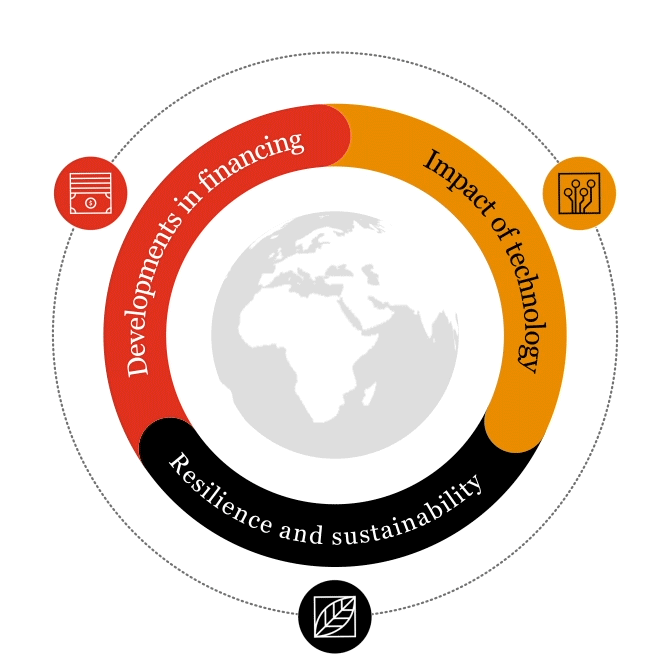
The global forces shaping the future of infrastructure
The infrastructure sector sits at a collision point of global disruptions, including shifts in capital availability, evolving social and environmental priorities, and rapid urbanisation. However, the emergence of COVID-19 introduces an altogether new set of challenges. The full impact of the pandemic will take years to play out. Yet in the near term, we believe it will reshape the industry in four ways, intensifying its focus on operational resilience, the affordability of infrastructure, the deployment of new technologies and the need for sustainability. Successful infrastructure delivery demands close alignment and collaboration between a wide range of participants, each with its own agenda and interest. The result? No single player acting alone can effect real change in the sector.
In the rest of this series, we look at the overarching forces that will influence the future of the infrastructure industry, including
- developments in financing
- the impact of technology
- the need for resilience and sustainability.

Four ways that COVID-19 could reshape the infrastructure industry
In October 2019, we asked infrastructure CEOs across the world to look ahead to 2020. Though most said they were expecting the pace of economic growth to slow during the year and were planning their growth strategies accordingly, nobody could have anticipated the COVID-19 pandemic. Given the crisis sudden sharp impacts and a long potential duration of intensity, the economic fallout of the crisis will test the resilience of the infrastructure sector.
Potential changes in demand
The forced cessation of travel, disruptions to supply chains and changes in consumer behaviour are among the COVID-19 impacts that are affecting every sector of infrastructure. Lockdown measures have resulted in a sudden decline in public transport and road infrastructure usage, causing formerly stable demand and revenues to diminish overnight. Against this background, transport asset owners are wondering whether the sudden move to remote working will lead to a permanent shift in working patterns, with consequent impacts on other industries, such as real estate. The shutdown could also lead to a shift from mass transit to micro-mobility options, which would affect future infrastructure planning.
Questions are also being raised about the air travel and freight industries. If usage of air transport declines significantly, will the aviation sector need to consider fundamental changes in how airports are designed and built? And what would a switch to more localised supply chains do to volumes and demand for port owners and operators?
The power sector is not immune either. In the UK, for example, overall demand for electricity has declined due to the lockdown. As a recent PwC study has highlighted, the coincidence of COVID-19 with an oil price crash in March 2020 is likely to affect the transition to renewable energy in the short term, with cheap oil lessening the attractiveness of investment in renewables, because oil-run generators will be more cost-effective.
It’s impossible to map out how the crisis will ultimately affect the infrastructure sector as a whole. But we believe the most immediate effects will be felt in four areas: operational resilience, technology adoption, affordability and sustainability.
Impact areas
- Operational resilience
- Technology adoption
- Affordability
- Sustainability
Operational resilience
The COVID-19 outbreak has brought operational resilience into sharp focus, particularly by exposing the fragility of supply chains. The Western reliance on Asian manufacturing has never been more apparent, as companies have had to quickly identify secondary suppliers, preferably local ones, because logistics options were also closed off.
Supply value chains cannot be established overnight — especially complex, globalised material supply chains of the kind required for large-scale capital projects. And the redesign of supply chains is likely not feasible in the current disruptive environment. Yet once the immediate crisis has passed, infrastructure CEOs will need to rethink their supply chains to build in as much resilience to global shocks and disruptions as possible.
Alongside some more obvious steps — such as a shift away from sole-supplier relationships[1] (be they with individual countries or companies) — we could see developments such as
- the introduction of new assessment criteria, such as responsiveness and resilience (along with more comprehensive business continuity plans among suppliers), to complement existing parameters such as cost and quality
- deployment of supply chain visibility tools that provide transparency into capacity constraints at first-, second- and third-tier suppliers
- increased use of tools and technologies to develop predictive models for proactive scheduling and dynamic planning that account for uncertainties and risks.
In addition to rethinking their supply chains, management teams will also need to re-examine their approach to project delivery and maintenance. COVID-19 led to the closure of construction sites around the world as employee safety plans were activated. Travel bans have had a direct impact on the availability of labour. The construction industry’s workforce is particularly vulnerable to labour restrictions, given that most of the work must take place onsite. However, the disruption to onsite staff operations could also accelerate new types of project workflows, such as modular and offsite production.
Taking construction offsite or into a manufacturing environment opens the door to more standardised designs, streamlined processes and automated production techniques that incorporate technologies such as advanced robotics and the Internet of Things. And advocates say that modular construction is faster, safer and more efficient than onsite building and assembly.[2]
[1] For example, Tesla recently announced a strategic partnership with Chinese manufacturer CATL to supply electric vehicle batteries for Model 3 production in China, shifting away from its sole-supplier relationship with Panasonic.
[2] Modular building removes 80% of the construction activity from the actual site location.


















